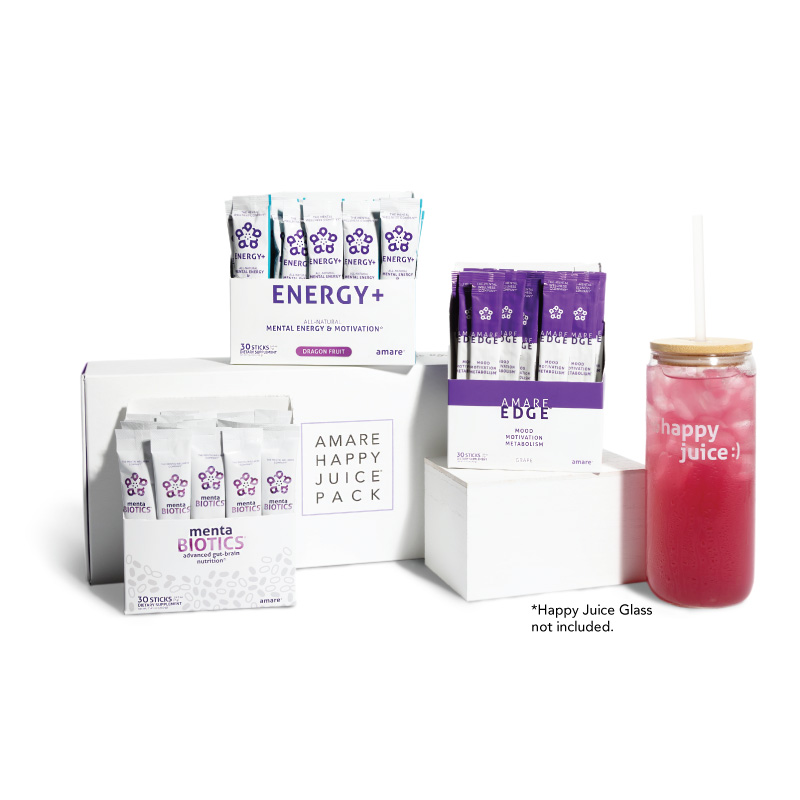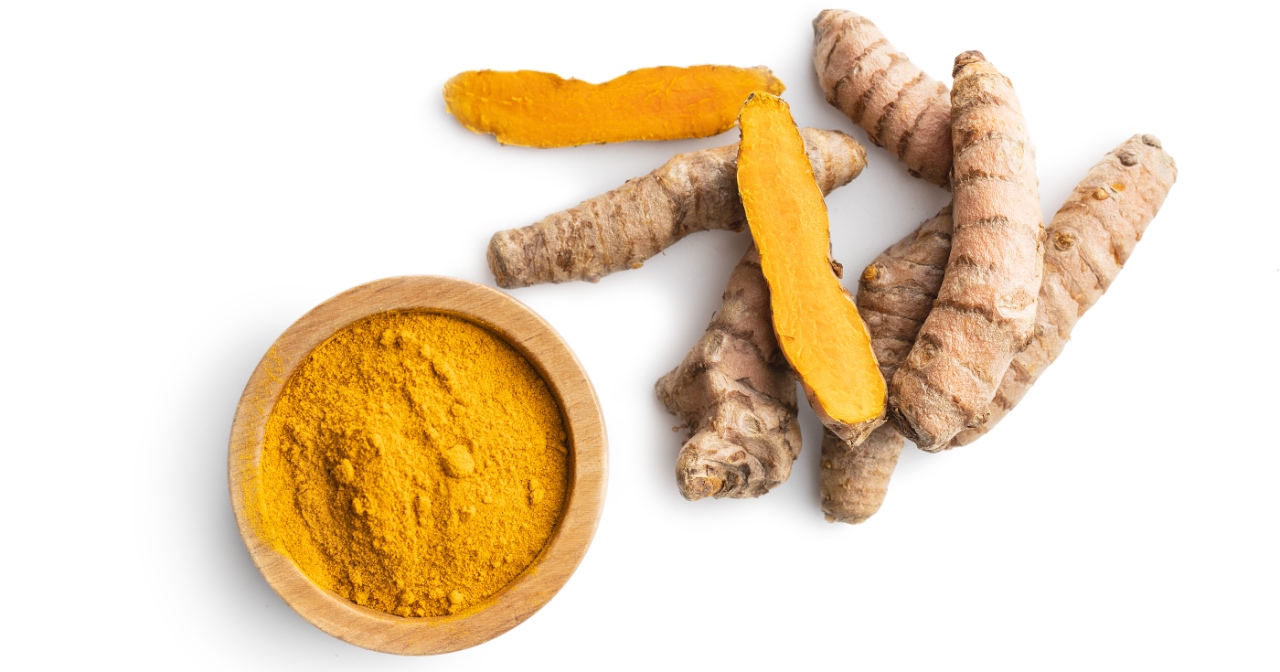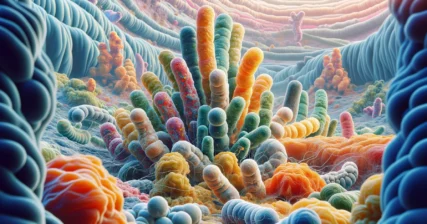Listen on: Apple Podcasts | Spotify
Turmeric (Curcuma longa L.) contains one of the most-researched, most-compelling compounds in all of nutrition and natural medicine: curcumin.
Traditional medicine practitioners have prescribed various forms of turmeric for more than 5000 years. More than 10,000 research papers and articles from just the past seven years focus on the physiological effects and health benefits of curcumin.
And yet, only a small percentage of the population knows about it. Of those who do, many attempt to get the health benefits through inferior sources and delivery methods.
What are turmeric and curcumin?
Turmeric is a plant that belongs to the ginger family. It originates in India, though it’s now grown throughout much of the world. If you’ve eaten Indian food or some Asian foods, you’ve probably eaten turmeric. The curry spice adds a distinct flavor and color.
Turmeric contains many compounds but demethoxycrucumin (DMC), bisdemethoxycurcumin (BMC), and curcumin (CUR) are the three most-well known curcuminoids found in turmeric. Curcuminoids make up 2%–9% of turmeric, and of the curcuminoids, curcumin makes up 77%.
Curcumin seems to offer the greatest range of health benefits, so many supplement makers isolate curcumin. Some use a concentrated form of turmeric.
Scientists isolated curcumin for the first time in 1815. The first research study on curcumin related to human health benefits was published in 1937.
Manufacturers usually extract curcumin with ethanol. However, they can also extract curcumin with:
- chlorine
- ultrasound
- microwave
- supercritical carbon dioxide
Scientists have also discovered how to chemically synthesize curcumin, which could be useful if demands exceed natural supplies.
As you’ll see, curcumin acts on a variety of systems and pathways throughout the body. It modulates numerous biological targets, including:
- apoptotic proteins
- cell cycle proteins
- cytokines
- enzymes
- growth factors
- inflammatory mediators
- protein kinases
- transcription factors
Health Benefits
Indian medicine practitioners use curcumin for anorexia, coughs, diabetic wounds, to support liver health, to relieve rheumatoid arthritis, and to support inflamed sinuses.
Hindu medicine practitioners use curcumin for muscle and tendon injuries. Chinese medicine practitioners use it to relieve abdominal pain.
Ayurvedic medicine texts recommend curcumin for obesity. It’s also used for arthritis, trauma, ulcers, jaundice, and psoriasis.
Research shows curcumin has “anti-inflammatory, anti-HIV, antibacterial, antifungal, nematocidal, anti-parasitic, anti-mutagenic, antidiabetic, antifibringoenic, radioprotective, wound-healing, lipid-lowering, antispasmodic, antioxidant, immunomodulating, anti-carcinogenic” effects.
Doctors may recommend it for people with:
- Cancer
- Diabetes
- Cystic fibrosis
- Malaria
- Hypertension
- Alzheimer’s disease
- Multiple sclerosis
- Parkinson’s disease
- Insect repellant
- Allergies
- Arthritis
Inflammation & Pain
Inflammation is at the core of numerous health problems, like irritable bowel syndrome (IBS), cardiovascular disease, arthritis or dementia. Because curcumin supports a normal inflammatory response, it may help with those dealing with any such condition.
Signs of IBS include increased stool frequency, bloating and abdominal pain. These changes are likely cause by inflamed intestinal mucosa.
In one study, a dose of just 144 mg of turmeric extract resulted in a 60 percent decrease in IBS symptoms in 105 adults.
Many inflammatory conditions cause pain. Studies suggest that curcumin may be a safe and effective way to help those with acute or chronic pain.
A small study with individuals experiencing pain showed that a dose of 2 grams of curcumin phytosome led to significant relief. The results were even superior to acetaminophen.
In another study with patients with osteoarthritis, pain significantly decreased and walking performance improved with a dose of 1 gram of curcumin phytosome per day.
Due to its impact on inflammation, it may help reduce symptoms of other inflammation-related conditions such as asthma, arthritis, and fibromyalgia.
Tissue repair, muscle and joint health
Research shows curcumin reduced delayed onset muscle soreness. While this may be due in part to its effects on inflammation, animal research shows that curcumin also enhances muscle tissue regeneration, which means your muscles recover faster after intense training.
Non-steroidal anti-inflammatory drugs (NSAIDs) also reduce inflammation and soreness post-exercise. However, their long-term use can actually interfere with muscle growth. Curcumin, on the other hand, supports normal inflammatory levels, reduces post-exercise soreness, and enhances muscle growth.
This also makes it a great addition to a post-injury rehab protocol, like when I tore my distal bicep tendon.
As it supports a healthy inflammatory response, turmeric may also enhance joint function.
Antioxidant
Curcumin acts as a potent antioxidant. It also enhances the activity of antioxidant-related enzymes and detoxification-related enzymes, and increases levels of glutathione, the body’s primary antioxidant.
Free radicals play a role in aging, development of disease, and the general breakdown of your body. As such, the antioxidant effects likely contribute to most, if not all of the turmeric’s health benefits.
Weight Management and Metabolic Syndrome
More than 300 papers have been published about curcumin’s role in supporting weight management.
Curcumin’s effect on weight management first came to light in 1973, with research showing that it could help normalize blood sugar levels. Curcumin has been shown to improve beta-cell function, which could be one of the reasons it improves blood sugar levels.
Metabolic syndrome and overweight or obesity often go hand in hand. Curcumin may be valuable in both conditions as it has been shown to positively affect blood lipid levels, blood glucose and glycated hemoglobin (HbA1c), decrease fatty acid synthesis and affect many other hormonal pathways related to obesity.
Adiponectin levels are usually low in overweight and obese individuals. Turmeric enhances adiponectin expression which may help improve body fat levels. It may also reduce expression of an enzyme that triggers cortisol secretion. Lower cortisol levels may reduce body fat, especially around the midsection.
Overall, we have found that curcumin intake among patients with metabolic syndrome and related disorders was correlated with a significant reduction in BMI, weight, WC (waist circumference), and leptin, and a significant increase in adiponectin levels, but did not affect HR (hip ratio).
Akbari M et al.
Cognitive Function and Emotional Wellbeing
Turmeric affects a number of neurotransmitters, including norepinephrine, dopamine and serotonin.
Serotonin is most known for its effect on sleep, but it also plays roles in appetite, memory, learning, mood, temperature regulation and cardiovascular function. Dopamine is essential for experiencing pleasure. Norepinephrine is necessary for attentiveness and focus, but is also important for supporting deep sleep and learning.
In affecting these neruotransmitters, it may affect mood. Curcumin may also enhance brain health.
Curcumin has ben shown to improve levels of brain-derived neurotrophic factor (BDNF). BDNF helps to stimulate the development of new brain cells. This effect is similar to the effects of aerobic exercise, which has also been shown to increase BDNF levels.
Also of interest, curcumin seems to stimulate vasodilation, or opening of the blood vessels in a similar way to cardiovascular exercise.
It’s not surprising then, that:
Curcumin has also demonstrated neuroprotective effects in animal models of Alzheimer’s disease, Parkinson’s disease, schizophrenia, drug addiction, Prion’s infection, stroke, aluminum neurotoxicity, epilepsy, and diabetic neuropathy.
Kulkarni SK et al.
Cancer
Preclinical research has shown curcumin inhibits growth of certain cancer types. Because of curcumin’s effect on inflammation, it may be beneficial in colorectal, pancreatic, breast, hepatic, oral and prostate cancers as well as leukemia.
It’s believed that curcumin’s cancer-related benefits come from its ability to affect apoptosis, or programmed cell death. This is one of the many wonders of the body. When cells become damaged enough, they’re supposed to self-destruct and die.
Unfortunately, when the process of apoptosis becomes dysfunctional, these damaged cells may lead to cancer, as well as autoimmune or degenerative diseases. It is believed that curcumin may have a positive effect on cancer growth by helping the cells overcome their apoptosis dysfunction.
Cancer patients should always talk with their doctor before using curcumin (or any other nutritional supplement) as there is some evidence that curcumin may interfere with some chemotherapy drugs.
Skin health
Because turmeric supports normal inflammation levels and acts as an antioxidant, research shows it may be a great complement to treatments for skin conditions like psoriasis, atopic dermatitis, iatrogenic dermatitis, skin cancer, skin infections, and aging skin.
However, it should not be considered a “treatment” for such conditions. If you have such a condition, work with your doctor about the appropriate treatment protocol.
Additional Benefits
With the massive amount of curcumin research available, it would be impossible to cover it all in a single blog post. For the sake of brevity, research indicates turmeric also:
- supports normal cholesterol levels and increased apolipoprotein (a)
- limits oxidation of LDL cholesterol
- reduces effects of hangovers
- supports erectile function
- supports cardiovascular health
Absorption and Bioavailability
As compelling as the research is on curcumin, the greatest obstacle is its very low level of absorption. Pure curcumin extract is not absorbed well at all, although consuming turmeric or curcumin with fat does assist in absorption. Coconut milk, butter or cooking oils may help with absorption when the spice is used in food.
In one study, a dose of two grams of pure curcumin extract was given to fasted participants to ingest. No curcumin was detectable in the blood afterwards, meaning none of the curcumin, or an extremely small amount, was absorbed.
For a supplement, don’t waste your money on pure curcumin or turmeric. Over the past decade, supplement manufacturers have created a number of forms that significantly increase absorption and bioavailability.
Delivery systems as micelles, liposomes, phospholipid complexes, microemulsions, nano-emulsions, emulsions, solid lipid nanoparticles, nanostructured lipid carriers, biopolymer nanoparticles and microgels exhibit greatest promise. They enhance efficacy, and also increase curcumin bioavailability by enhancing small intestine permeation, preventing possible degradation in the microenvironment, increasing plasma half-life and enhancing curcumin efficacy.
Stohs SJ et al.
At the time of this publication, the most bioavailable turmeric delivery system is a patent pending water-dispersible colloidal suspension.
The recommended dosage is 300 mg, which provides 90 mg of total curcuminoids, of which curcumin makes up 69 mg.
To achieve the same level of curcumin absorption as the 300 mg dose of the water-dispersible colloidal suspension, you’d need to take:
- 1922 mg of standard turmeric extract (95% curcuminoids)
- 2264 mg of turmeric as a 95% curcuminoids-piperine combination
- 763 mg of liquid micellar formulation
- 2872 mg of curcumin phytosome (20% curcuminoids)
If you haven’t looked deep into curcumin supplements before, these numbers and terms might not mean a lot. I bring them up, though, to say that there is a superior curcumin delivery system that maximizes bioavailability, and therefore improves the likelihood you’ll benefit from your supplement.
For now, the water-dispersible colloidal suspension form of turmeric extract is the best form of curcumin on the market.
Summary
I’ve taken a curcumin supplement every day since 2014 when I tore my bicep tendon. Though it’s not one of my Foundational Five, the health benefits are too numerous to not take it on a daily basis.
Until recently, I took curcumin phytosome. Now that an even more bioavailable form is available, I’ve switched up my supplement routine and consume the water-dispersible colloidal suspension form of turmeric as a beverage each day.

Feel Better Fast. Guaranteed.
Energy+, EDGE, and MentaBiotics make up the Happy Juice supplement stack, with ingredients clinically proven to:
- decrease anxiousness scores by 55%
- decrease irritability scores by 60%
- decrease fatigue by 64%
- decrease anger 54%
- decrease tension by 45%
- decrease confusion by 43%
- decrease overall distress by 49%
- increase good bacteria by 70%
- decrease negative mood by 105%
- increase positive mood by 211%
References
A Critical Review of the Properties and Analytical Methods for the Determination of Curcumin in Biological and Pharmaceutical Matrices – PubMed. https://pubmed.ncbi.nlm.nih.gov/30252504/. Accessed 21 June 2021.
Aggarwal, Bharat B., et al. “Anticancer Potential of Curcumin: Preclinical and Clinical Studies.” Anticancer Research, vol. 23, no. 1A, Feb. 2003, pp. 363–98. —. “Targeting Inflammation-Induced Obesity and Metabolic Diseases by Curcumin and Other Nutraceuticals.” Annual Review of Nutrition, vol. 30, Aug. 2010, pp. 173–99. PubMed, doi:10.1146/annurev.nutr.012809.104755.
Akazawa, Nobuhiko, et al. “Curcumin Ingestion and Exercise Training Improve Vascular Endothelial Function in Postmenopausal Women.” Nutrition Research (New York, N.Y.), vol. 32, no. 10, Oct. 2012, pp. 795–99. PubMed, doi:10.1016/j.nutres.2012.09.002. Ammon, H. P., et al. “Curcumin: A Potent Inhibitor of Leukotriene B4 Formation in Rat Peritoneal Polymorphonuclear Neutrophils (PMNL).” Planta Medica, vol. 58, no. 2, Apr. 1992, p. 226. PubMed, doi:10.1055/s-2006-961438.
Ammon, H. P., and M. A. Wahl. “Pharmacology of Curcuma Longa.” Planta Medica, vol. 57, no. 1, Feb. 1991, pp. 1–7. PubMed, doi:10.1055/s-2006-960004.
Belcaro, G., et al. “Product-Evaluation Registry of Meriva®, a Curcumin-Phosphatidylcholine Complex, for the Complementary Management of Osteoarthritis.” Panminerva Medica, vol. 52, no. 2 Suppl 1, June 2010, pp. 55–62.
Belcaro, Gianni, et al. “Efficacy and Safety of Meriva®, a Curcumin-Phosphatidylcholine Complex, during Extended Administration in Osteoarthritis Patients.” Alternative Medicine Review: A Journal of Clinical Therapeutic, vol. 15, no. 4, Dec. 2010, pp. 337–44.
Bundy, Rafe, et al. “Turmeric Extract May Improve Irritable Bowel Syndrome Symptomology in Otherwise Healthy Adults: A Pilot Study.” Journal of Alternative and Complementary Medicine (New York, N.Y.), vol. 10, no. 6, Dec. 2004, pp. 1015–18. PubMed, doi:10.1089/acm.2004.10.1015.
Chuengsamarn, Somlak, et al. “Curcumin Extract for Prevention of Type 2 Diabetes.” Diabetes Care, vol. 35, no. 11, Nov. 2012, pp. 2121–27. PubMed, doi:10.2337/dc12-0116.
Di Pierro, Francesco, et al. “Comparative Evaluation of the Pain-Relieving Properties of a Lecithinized Formulation of Curcumin (Meriva(®)), Nimesulide, and Acetaminophen.” Journal of Pain Research, vol. 6, 2013, pp. 201–05. PubMed, doi:10.2147/JPR.S42184.
Drobnic, Franchek, et al. “Reduction of Delayed Onset Muscle Soreness by a Novel Curcumin Delivery System (Meriva®): A Randomised, Placebo-Controlled Trial.” Journal of the International Society of Sports Nutrition, vol. 11, 2014, p. 31. PubMed, doi:10.1186/1550-2783-11-31.
Effect of Curcumin on Blood Sugar as Seen in a Diabetic Subject – PubMed. https://pubmed.ncbi.nlm.nih.gov/4637293/. Accessed 23 June 2021.
“Evidence from our clinical pharmacokinetic study.” TurmiPureGold – Naturex, https://www.turmipuregold.com/our-science/pharmacokinetic-study/. Accessed 23 June 2021.
Hu, Shuxin, et al. “Clinical Development of Curcumin in Neurodegenerative Disease.” Expert Review of Neurotherapeutics, vol. 15, no. 6, June 2015, pp. 629–37. PubMed, doi:10.1586/14737175.2015.1044981.
Johnson, Jeremy James, and Hasan Mukhtar. “Curcumin for Chemoprevention of Colon Cancer.” Cancer Letters, vol. 255, no. 2, Oct. 2007, pp. 170–81. PubMed, doi:10.1016/j.canlet.2007.03.005.
Jurenka, Julie S. “Anti-Inflammatory Properties of Curcumin, a Major Constituent of Curcuma Longa: A Review of Preclinical and Clinical Research.” Alternative Medicine Review: A Journal of Clinical Therapeutic, vol. 14, no. 2, June 2009, pp. 141–53.
Kulkarni, Shrinivas, et al. “Potentials of Curcumin as an Antidepressant.” TheScientificWorldJournal, vol. 9, Nov. 2009, pp. 1233–41. ResearchGate, doi:10.1100/tsw.2009.137.
Kulkarni, Shrinivas K., et al. “Antidepressant Activity of Curcumin: Involvement of Serotonin and Dopamine System.” Psychopharmacology, vol. 201, no. 3, Dec. 2008, pp. 435–42. PubMed, doi:10.1007/s00213-008-1300-y.
Lao, Christopher D., et al. “Dose Escalation of a Curcuminoid Formulation.” BMC Complementary and Alternative Medicine, vol. 6, Mar. 2006, p. 10. PubMed, doi:10.1186/1472-6882-6-10.
Leiherer, Andreas, et al. “Phytochemicals and Their Impact on Adipose Tissue Inflammation and Diabetes.” Vascular Pharmacology, vol. 58, no. 1–2, Jan. 2013, pp. 3–20. PubMed, doi:10.1016/j.vph.2012.09.002.
Nelson, Kathryn M., et al. “The Essential Medicinal Chemistry of Curcumin.” Journal of Medicinal Chemistry, vol. 60, no. 5, Mar. 2017, pp. 1620–37. PubMed Central, doi:10.1021/acs.jmedchem.6b00975.
Niranjan, Abhishek, and Dhan Prof. “Chemical Constituents and Biological Activities of Turmeric (Curcuma Longa L.) -A Review.” Journal of Food Science and Technology, vol. 45, Mar. 2008, pp. 109–16.
Oppenheimer, Albert. “TURMERIC (CURCUMIN) IN BILIARY DISEASES.” The Lancet, vol. 229, no. 5924, Mar. 1937, pp. 619–21. ScienceDirect, doi:10.1016/S0140-6736(00)98193-5.
Panahi, Yunes, et al. “Antioxidant and Anti-Inflammatory Effects of Curcuminoid-Piperine Combination in Subjects with Metabolic Syndrome: A Randomized Controlled Trial and an Updated Meta-Analysis.” Clinical Nutrition (Edinburgh, Scotland), vol. 34, no. 6, Dec. 2015, pp. 1101–08. PubMed, doi:10.1016/j.clnu.2014.12.019.
(PDF) Potentials of Curcumin as an Antidepressant. https://www.researchgate.net/publication/38060281_Potentials_of_Curcumin_as_an_Antidepressant. Accessed 23 June 2021.
Pharmacology of Curcuma Longa – PubMed. https://pubmed.ncbi.nlm.nih.gov/2062949/. Accessed 23 June 2021.
Phase I Clinical Trial of Oral Curcumin | Clinical Cancer Research. https://clincancerres.aacrjournals.org/content/10/20/6847. Accessed 5 June 2020.
Prasad, Sahdeo, et al. “Curcumin, a Component of Golden Spice: From Bedside to Bench and Back.” Biotechnology Advances, vol. 32, no. 6, Nov. 2014, pp. 1053–64. PubMed, doi:10.1016/j.biotechadv.2014.04.004.
Priyadarsini, Kavirayani Indira. “The Chemistry of Curcumin: From Extraction to Therapeutic Agent.” Molecules, vol. 19, no. 12, Dec. 2014, pp. 20091–112. PubMed Central, doi:10.3390/molecules191220091.
Ramírez-Boscá, A., et al. “An Hydroalcoholic Extract of Curcuma Longa Lowers the Apo B/Apo A Ratio. Implications for Atherogenesis Prevention.” Mechanisms of Ageing and Development, vol. 119, no. 1–2, Oct. 2000, pp. 41–47. PubMed, doi:10.1016/s0047-6374(00)00169-x.
Ramírez-Tortosa, M. C., et al. “Influence of Dietary Lipids on Lipoprotein Composition and LDL Cu(2+)-Induced Oxidation in Rabbits with Experimental Atherosclerosis.” BioFactors (Oxford, England), vol. 8, no. 1–2, 1998, pp. 79–85. PubMed, doi:10.1002/biof.5520080114.
Scartezzini, P., and E. Speroni. “Review on Some Plants of Indian Traditional Medicine with Antioxidant Activity.” Journal of Ethnopharmacology, vol. 71, no. 1–2, July 2000, pp. 23–43. PubMed, doi:10.1016/s0378-8741(00)00213-0.
Singh, N., and S. Anand. “Apoptosis in Health and Disease.” Indian Journal of Physiology and Pharmacology, vol. 39, no. 2, Apr. 1995, pp. 91–94. Singh, Seema. “From Exotic Spice to Modern Drug?” Cell, vol. 130, no. 5, Sept. 2007, pp. 765–68. PubMed, doi:10.1016/j.cell.2007.08.024.
Somasundaram, Sivagurunathan, et al. “Dietary Curcumin Inhibits Chemotherapy-Induced Apoptosis in Models of Human Breast Cancer.” Cancer Research, vol. 62, no. 13, July 2002, pp. 3868–75. Srinivasan, M. “Effect of Curcumin on Blood Sugar as Seen in a Diabetic Subject.” Indian Journal of Medical Sciences, vol. 26, no. 4, Apr. 1972, pp. 269–70.
Stohs, Sidney J., et al. “Highly Bioavailable Forms of Curcumin and Promising Avenues for Curcumin-Based Research and Application: A Review.” Molecules, vol. 25, no. 6, Mar. 2020, p. 1397. PubMed Central, doi:10.3390/molecules25061397.
Thaloor, D., et al. “Systemic Administration of the NF-KappaB Inhibitor Curcumin Stimulates Muscle Regeneration after Traumatic Injury.” The American Journal of Physiology, vol. 277, no. 2, 1999, pp. C320-329. PubMed, doi:10.1152/ajpcell.1999.277.2.C320.
Vollono, Laura, et al. “Potential of Curcumin in Skin Disorders.” Nutrients, vol. 11, no. 9, Sept. 2019, p. 2169. PubMed Central, doi:10.3390/nu11092169.
Weisberg, Stuart P., et al. “Dietary Curcumin Significantly Improves Obesity-Associated Inflammation and Diabetes in Mouse Models of Diabesity.” Endocrinology, vol. 149, no. 7, July 2008, pp. 3549–58. PubMed, doi:10.1210/en.2008-0262.
Xu, Ying, et al. “The Effects of Curcumin on Depressive-like Behaviors in Mice.” European Journal of Pharmacology, vol. 518, no. 1, July 2005, pp. 40–46. PubMed, doi:10.1016/j.ejphar.2005.06.002.
Yue, Grace G. L., et al. “Evaluation of in Vitro Anti-Proliferative and Immunomodulatory Activities of Compounds Isolated from Curcuma Longa.” Food and Chemical Toxicology: An International Journal Published for the British Industrial Biological Research Association, vol. 48, no. 8–9, Sept. 2010, pp. 2011–20. PubMed, doi:10.1016/j.fct.2010.04.039.
Zhou, Hongyu, et al. “Targets of Curcumin.” Current Drug Targets, vol. 12, no. 3, Mar. 2011, pp. 332–47.



